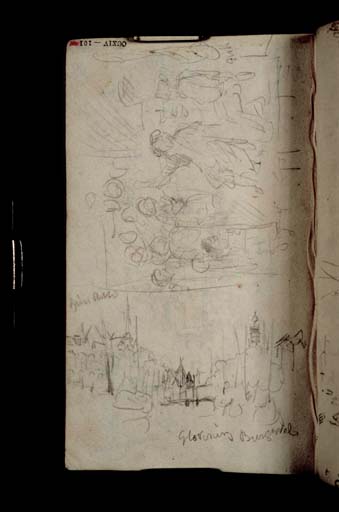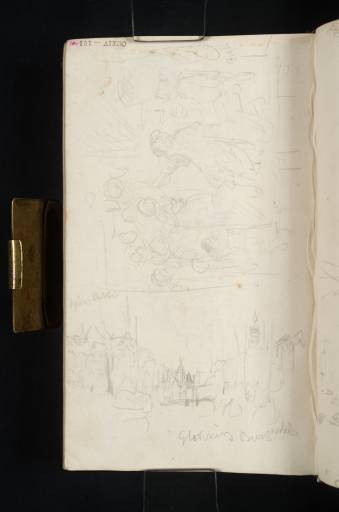Joseph Mallord William Turner The Kloveniersburgwal Canal, Amsterdam, with the Waag Gatehouse in the Distance; ?Copy of a Seventeenth-Century Painting of a Tavern Scene 1825
Image 1 of 2
-
 Joseph Mallord William Turner, The Kloveniersburgwal Canal, Amsterdam, with the Waag Gatehouse in the Distance; ?Copy of a Seventeenth-Century Painting of a Tavern Scene 1825
Joseph Mallord William Turner, The Kloveniersburgwal Canal, Amsterdam, with the Waag Gatehouse in the Distance; ?Copy of a Seventeenth-Century Painting of a Tavern Scene 1825 -
 Joseph Mallord William Turner, The Kloveniersburgwal Canal, Amsterdam, with the Waag Gatehouse in the Distance; ?Copy of a Seventeenth-Century Painting of a Tavern Scene 1825 (Enhanced image)Enhanced image
Joseph Mallord William Turner, The Kloveniersburgwal Canal, Amsterdam, with the Waag Gatehouse in the Distance; ?Copy of a Seventeenth-Century Painting of a Tavern Scene 1825 (Enhanced image)Enhanced image
Joseph Mallord William Turner,
The Kloveniersburgwal Canal, Amsterdam, with the Waag Gatehouse in the Distance; ?Copy of a Seventeenth-Century Painting of a Tavern Scene
1825
Joseph Mallord William Turner 1775–1851
Folio 101 Recto:
The Kloveniersburgwal Canal, Amsterdam, with the Waag Gatehouse in the Distance; ?Copy of a Seventeenth-Century Painting of a Tavern Scene 1825
D19039
Turner Bequest CCXIV 101
Turner Bequest CCXIV 101
Pencil on white wove paper, 155 x 95 mm
Inscribed by Turner in pencil ‘Bains Publi[...]’ centre left, ‘Glovenirs Burgwal’ towards bottom right, and ‘fish’ top right, ascending vertically
Inscribed by John Ruskin in red ink ‘101’ top left, upside down
Stamped in black ‘CCXIV – 101’ top left, upside down
Inscribed by Turner in pencil ‘Bains Publi[...]’ centre left, ‘Glovenirs Burgwal’ towards bottom right, and ‘fish’ top right, ascending vertically
Inscribed by John Ruskin in red ink ‘101’ top left, upside down
Stamped in black ‘CCXIV – 101’ top left, upside down
Accepted by the nation as part of the Turner Bequest 1856
References
1909
A.J. Finberg, A Complete Inventory of the Drawings of the Turner Bequest, London 1909, vol.II, p.654, CCXIV 101, as ‘Street scene – “Glovinery (?), Burgeval (?)”; also copy of a picture – possibly a Rembrandt’.
Finberg later annotated his 1909 Inventory entry (‘Street scene – “Glovinery (?), Burgeval (?)”...’): ‘Burgwal. J.P H.’1 The initials are those of the etcher and collector John Postle Heseltine (1843–1929), whose occasional suggestions were acknowledged in this way. The bottom part of the page shows a view of the Kloveniersburgwal canal in the centre of Amsterdam, as signified by one of Turner’s inscriptions.
The viewpoint was likely the Oost-Indische Huisbrug, looking north-north-east past moored boast to the turrets of the Waag gatehouse in the distance past the Bushuissluis bridge. The spire of the Zuiderkerk (now an events venue) is on the right and the arched windows on the left are those of the Lutheran church (now the Compagnietheater). Turner’s other note presumably indicates a French-language sign for public baths. The Waag is shown from further off in the same direction on folio 100 recto (D19037) and in a closer view from the opposite direction on folio 100 verso opposite (D19038). See under folio 81 recto (D18999) for other views in and around the city in this book and elsewhere.
The Rijksmuseum art collection was at that time housed in the Trippenhuis mansion beside the canal,2 on the right past the Bushuissluis; Turner evidently visited it on this tour, as he made an annotated copy of a Ter Borch painting there on D18999. It seems likely that the subject occupying the upper half of the present page, separated from the canal view by a pencil line and drawn with the page turned horizontally, is taken from another work there or elsewhere in the city, although it awaits identification; Finberg suggested it as a ‘copy of a picture – possibly a Rembrandt’.3
It shows a busy scene centred on a seated man in some form of historical costume and hat, apparently raising his glass in a toast; there is a written note of ‘Fish’ within the right-hand side of the scene. The gesture is reminiscent of that adopted by Rembrandt (1606–1669) in his self-portrait with his wife of about 1635, known as Rembrandt und Saskia im Gleichnis vom verlorenen Sohn (Gemäldegalerie Alte Meister, Dresden), in the debonair Biblical character of the Prodigal Son. Tavern scenes are common in Dutch art of the period, and Turner was a confirmed admirer of Rembrandt’s,4 exhibiting one of his own paintings specifically emulating his style, Rembrandt’s Daughter (Fogg Art Museum, Cambridge, Massachusetts),5 at the Royal Academy in 1827, within two years of the present tour. See also the crowd scene, Pilate Washing his Hands, shown at the Academy in 1830 (Tate N00510).6
Matthew Imms and Quirine van der Meer Mohr
September 2020
Undated MS note by Finberg (died 1939) in interleaved copy of Finberg 1909, Prints and Drawings Room, Tate Britain, II, opposite p.654.
See ‘History of the Rijksmuseum’, Rijksmuseum, accessed 10 March 2020, https://www.rijksmuseum.nl/en/organisation/history-of-the-rijksmuseum .
See Alfred (Fred) Bachrach, ‘Rembrandt van Rijn (1606–69)’ in Evelyn Joll, Martin Butlin and Luke Herrmann eds., The Oxford Companion to J.M.W. Turner, Oxford 2001, pp.256–7.
Martin Butlin and Evelyn Joll, The Paintings of J.M.W. Turner, revised ed., New Haven and London 1984, pp.146–7 no.238, pl.244 (colour); see also Fred G.H. Bachrach, Turner’s Holland, exhibition catalogue, Tate Gallery, London 1994, pp.19, 48 no.12, reproduced in colour.
How to cite
Matthew Imms and Quirine van der Meer Mohr, ‘The Kloveniersburgwal Canal, Amsterdam, with the Waag Gatehouse in the Distance; ?Copy of a Seventeenth-Century Painting of a Tavern Scene 1825 by Joseph Mallord William Turner’, catalogue entry, September 2020, in David Blayney Brown (ed.), J.M.W. Turner: Sketchbooks, Drawings and Watercolours, Tate Research Publication, March 2023, https://www

